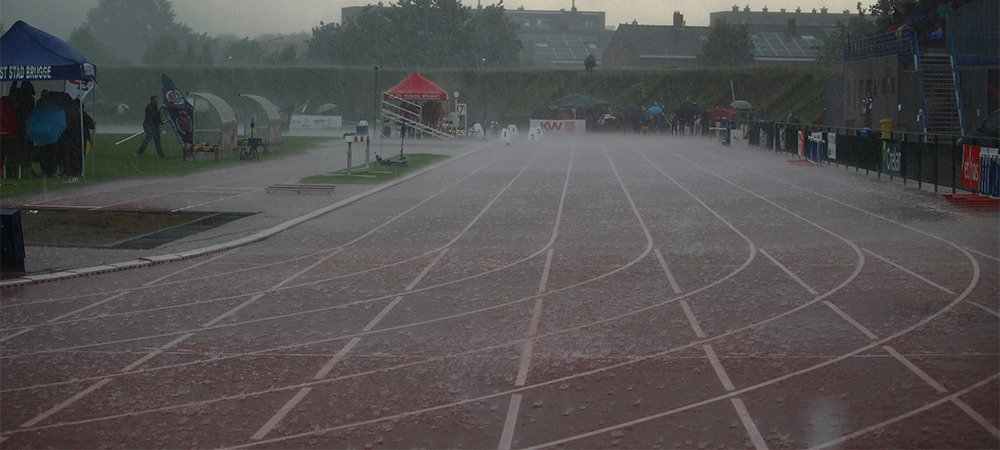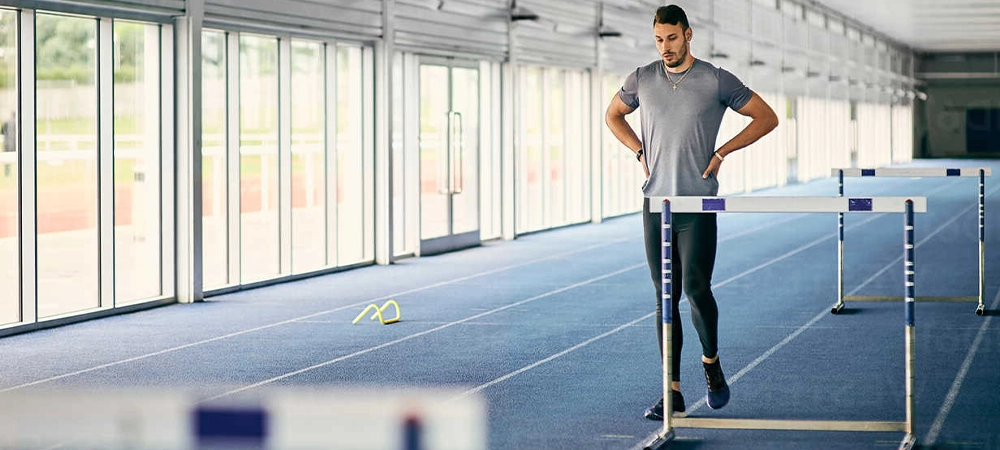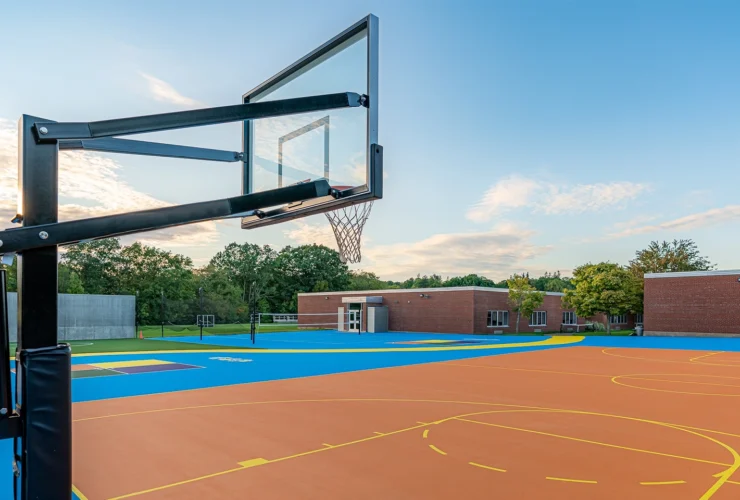Outdoor vs. Indoor Running Tracks: Which is Best for Your Needs?
Running has become a hugely popular way to stay fit, relieve stress, and enjoy the outdoors. But whether you’re a seasoned marathoner or just starting, your training environment plays a crucial role in your performance, comfort, and safety. The surface beneath your feet can significantly impact your stride, speed, and risk of injury.
In this blog post, we’ll explore the key differences between outdoor and indoor running tracks, examining their pros and cons to help you choose the best environment for your running needs.
Let us help you make an informed decision and optimize your running experience.
Related Article: Why Running Tracks Matter: Importance of Quality Surfaces in Brampton
Outdoor Running Tracks
For many runners, nothing beats the feeling of hitting the open road or trail. Outdoor running tracks offer a unique set of advantages.
Benefits
- Fresh Air and Natural Environment: Running in a natural environment provides a welcome escape from the confines of indoor spaces.
- Variety of Scenery and Terrain: Outdoor tracks offer a constantly changing landscape, from scenic parks and trails to bustling city streets. This variety can keep your runs interesting and prevent monotony.
- Longer Distances: Outdoor tracks often provide the opportunity for longer runs, allowing you to build endurance and explore new routes.
- Free and Accessible: Many outdoor tracks, such as those in parks or along public roads, are free and accessible to everyone, making them a convenient and affordable option for runners of all levels.
Drawbacks
However, outdoor tracks also come with some challenges:
- Exposure to Weather: Rain, snow, wind, and extreme temperatures can make outdoor running uncomfortable or even dangerous.
- Uneven Terrain and Hazards: Outdoor tracks may have uneven surfaces, potholes, or obstacles that can increase your risk of tripping or injury.
- Limited Amenities: Outdoor tracks may not have amenities like restrooms, water fountains, or changing rooms.
- Safety Concerns: Running outdoors, especially at night or in secluded areas, can pose safety risks.
Despite these drawbacks, outdoor running tracks offer a unique and rewarding experience for many runners. Weigh the pros and cons carefully to determine if an outdoor track aligns with your needs and preferences.

Indoor Running Tracks
When the weather outside isn’t cooperating, or you prefer a more controlled environment, indoor running tracks offer a valuable alternative.
Benefits
- Climate Control: Say goodbye to sweaty summer runs and icy winter jogs. Indoor tracks provide a consistent, comfortable temperature year-round, allowing you to focus on your workout without battling the elements.
- Predictable Surface: Indoor tracks typically feature smooth, even surfaces, reducing the risk of tripping or twisting an ankle on uneven terrain. This predictability can be especially beneficial for runners recovering from injuries or those who prefer a consistent stride.
- Amenities: Indoor facilities often offer amenities like restrooms, water fountains, lockers, and showers, adding convenience to your workout.
- Specialized Equipment: Many indoor tracks are located within gyms or fitness centres, providing access to treadmills, weights, and other equipment for cross-training or strength training.
- Safety: Indoor tracks generally offer a safer environment, especially for running at night or during inclement weather. They are well-lit and often have security measures in place.
Related Article: Top 5 Benefits of Having an Indoor Pickleball Court In Your Facility
Drawbacks
While indoor tracks offer many advantages, they also have some limitations:
- Monotony: Running in circles within a confined space can become repetitive and boring for some runners.
- Limited Space: Indoor tracks may have limited space, especially during peak hours. This can lead to crowding and a less enjoyable running experience.
- Access Restrictions: Indoor tracks are often located within gyms or fitness centres, which may require membership fees or have restricted access hours.
- Lack of Fresh Air and Scenery: While climate control is a plus, you miss out on the fresh air and natural scenery that outdoor running provides.
Track Surface Considerations
The surface of a running track can significantly impact your performance, comfort, and risk of injury. Different materials offer varying levels of shock absorption, energy return, and traction. Here’s a look at common track surfaces:
Outdoor Tracks
- Asphalt: A common and affordable option, asphalt provides a firm and durable surface. However, it offers less shock absorption than other materials, which can increase stress on joints.
- Rubberized Asphalt: This surface combines asphalt with a layer of rubber particles, providing improved shock absorption and traction. It’s a popular choice for recreational tracks and offers a good balance of durability and comfort.
- Synthetic Rubber: Often made from polyurethane or latex, synthetic rubber tracks offer excellent shock absorption, energy return, and traction. They are the preferred choice for competitive tracks and are designed to minimize the risk of injury while maximizing performance.
Impact on Performance and Injury Risk
The track surface can influence your running biomechanics, affecting your stride length, ground contact time, and overall efficiency. Surfaces with good shock absorption reduce the impact forces on your joints, lowering the risk of injuries like shin splints, stress fractures, and plantar fasciitis. Surfaces with good energy return can help propel you forward, potentially improving your speed and endurance.
Indoor Tracks
- Synthetic Rubber: Similar to outdoor synthetic tracks, indoor tracks often utilize rubberized surfaces for their shock absorption, energy return, and durability.
- Wood: Wood tracks offer a more traditional feel and can be aesthetically pleasing. However, they generally provide less shock absorption than synthetic rubber and may require more maintenance.
Benefits of Specialized Indoor Surfaces
Some indoor tracks feature specialized surfaces designed to further enhance performance and minimize injury risk. These surfaces may incorporate advanced technologies to optimize shock absorption, energy return, and traction. This can be particularly beneficial for high-impact activities or for runners recovering from injuries.
Related Article: Comparing Costs: Building an Outdoor Pickleball Court vs. Indoor

Choosing the Right Track for Your Needs
Now that you understand the characteristics of indoor and outdoor tracks, it’s time to consider your individual needs and preferences. Here’s a guide to help you choose the right track for your running goals:
Running Goals and Preferences
- Distance: If you enjoy long-distance running or are training for a marathon, an outdoor track with varied terrain might be ideal. For shorter distances or interval training, an indoor track with a predictable surface could be more suitable.
- Intensity: High-intensity workouts might be better suited for an indoor track with a controlled climate and a forgiving surface. For recovery runs or easy jogs, the fresh air and natural environment of an outdoor track might be more appealing.
- Weather Tolerance: If you don’t mind braving the elements, an outdoor track can provide a refreshing change of scenery. But if you prefer a consistent climate, an indoor track is the obvious choice.
- Experience Level: Beginners might find the controlled environment of an indoor track less intimidating. More experienced runners might prefer the challenge and variety of outdoor terrain.
Health and Injury Prevention
Consider your physical condition and any injury history when choosing a track.
- Joint Impact: If you have joint pain or are prone to injuries, prioritize tracks with good shock absorption, such as those with synthetic rubber surfaces.
- Injury Recovery: A smooth, predictable indoor track might be preferable for runners recovering from injuries, as it reduces the risk of unexpected twists or impacts.
Accessibility and Convenience
Think about practical factors when choosing a track:
- Location: Choose a track that is conveniently located and easily accessible.
- Cost: Consider any membership fees or access restrictions associated with indoor tracks.
- Amenities: If having access to restrooms, water fountains, and other amenities is important to you, an indoor track might be a better choice.
- Schedule: Consider the operating hours of indoor tracks and whether they align with your availability.
Related Article: Why Indoor Pickleball Courts Are Gaining Popularity: Trends and Insights
Crowall’s Expertise in Sports Surfaces
Crowall understands the nuances of creating high-performance running tracks. We utilize precision laser-guided grading techniques to ensure a perfectly level and consistent surface, whether it’s a sprawling outdoor track or a compact indoor facility.
We are committed to using premium materials and proven construction methods to deliver durable, safe, and aesthetically pleasing tracks that enhance the running experience for athletes of all levels.
Hit the Ground Running: Choosing the Right Track for You
Whether you prefer the fresh air and freedom of an outdoor track or the controlled environment of an indoor facility, the most important thing is to find a surface that supports your running journey and helps you achieve your goals.
If you’re considering building or resurfacing a running track, Crowall is your trusted partner. Contact us today for a free consultation, and let our expertise guide you in creating a high-quality track that meets your specific needs.



